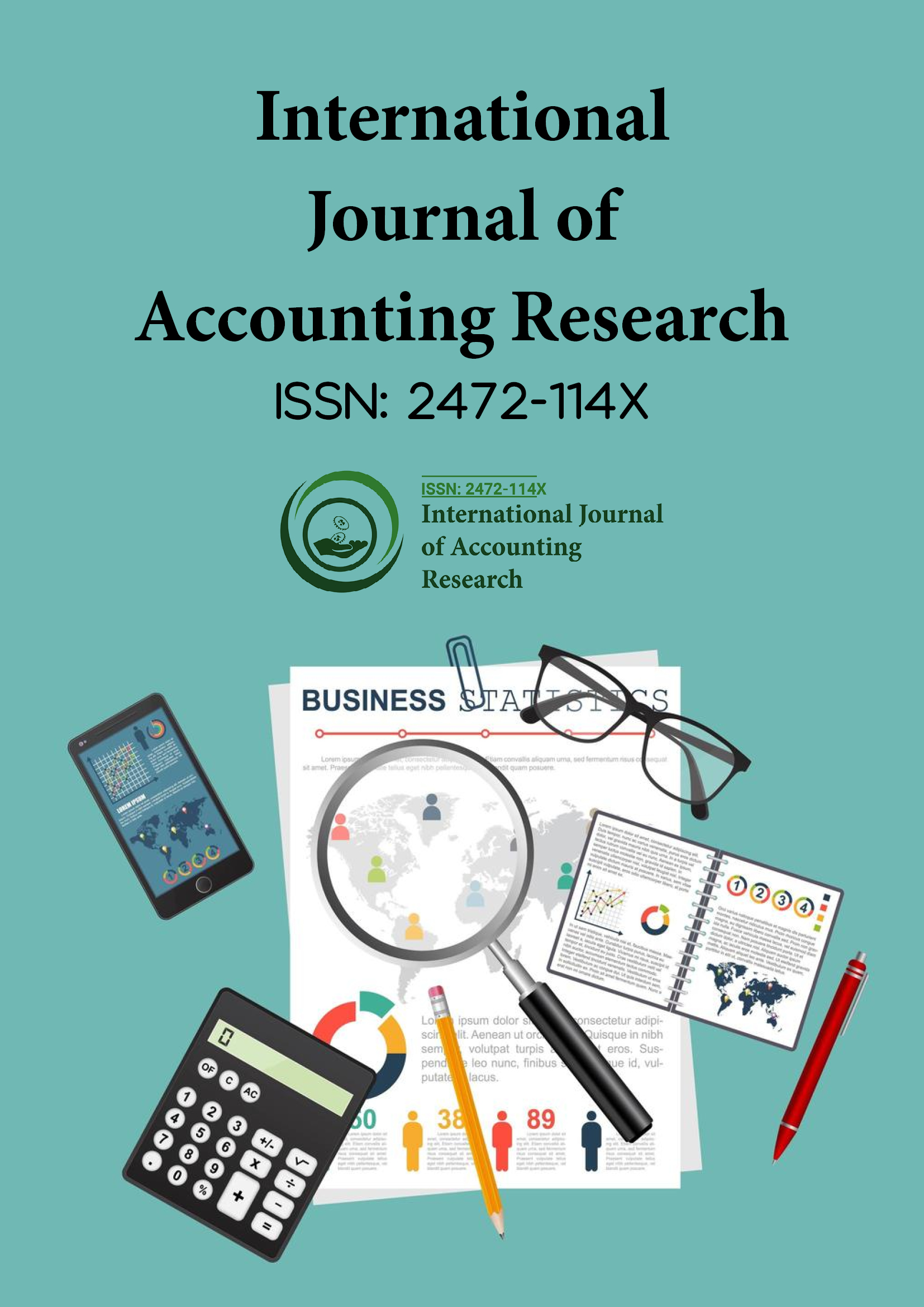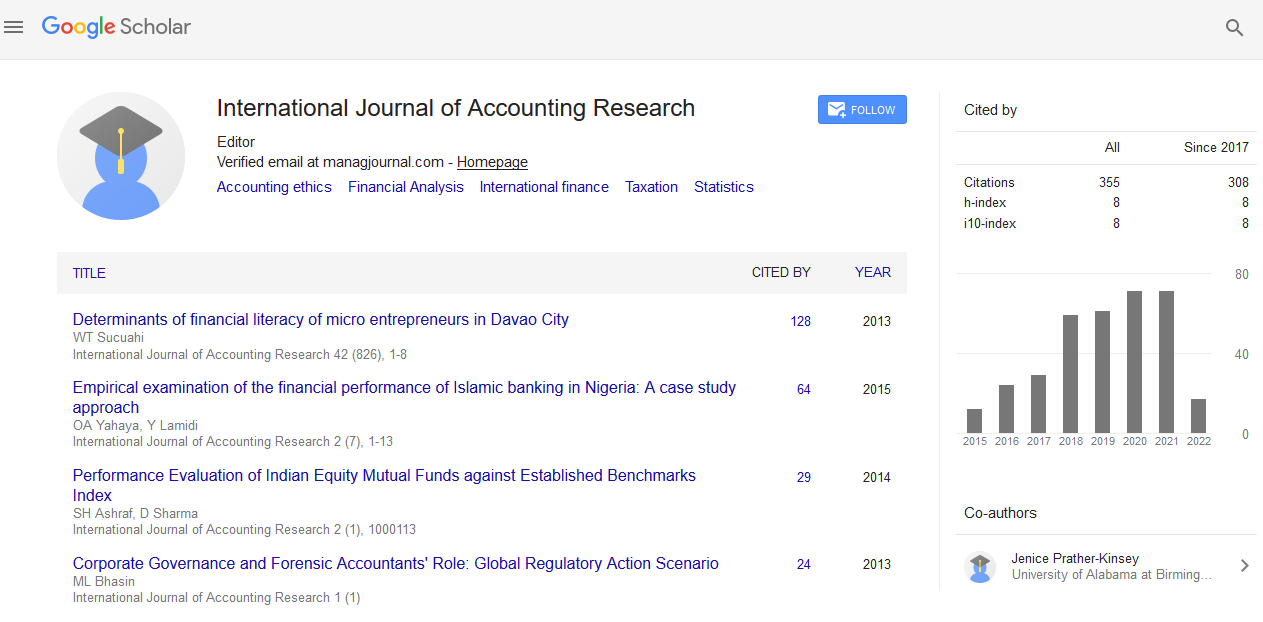Indexed In
- Open J Gate
- RefSeek
- Hamdard University
- EBSCO A-Z
- Scholarsteer
- Publons
- Euro Pub
- Google Scholar
Useful Links
Share This Page
Journal Flyer

Open Access Journals
- Agri and Aquaculture
- Biochemistry
- Bioinformatics & Systems Biology
- Business & Management
- Chemistry
- Clinical Sciences
- Engineering
- Food & Nutrition
- General Science
- Genetics & Molecular Biology
- Immunology & Microbiology
- Medical Sciences
- Neuroscience & Psychology
- Nursing & Health Care
- Pharmaceutical Sciences
Commentary - (2025) Volume 13, Issue 1
The Role of Forensic Accounting in Detecting Corporate Fraud
Olivia Bennett*Received: 03-Mar-2025, Manuscript No. IJAR-25-29093; Editor assigned: 05-Mar-2025, Pre QC No. IJAR-25-29093 (PQ); Reviewed: 19-Mar-2025, QC No. IJAR-25-29093; Revised: 26-Mar-2025, Manuscript No. IJAR-25-29093 (R); Published: 02-Apr-2025, DOI: 10.35248/2472-114X.25.13.407
Description
Forensic accounting has emerged as a vital discipline within the broader accounting profession, playing a central role in the detection and prevention of corporate fraud. In an era where financial manipulation can destabilize entire economies, the role of forensic accountants has become indispensable. These professionals apply accounting, auditing, and investigative skills to examine financial statements, trace asset movements, and identify inconsistencies that may indicate fraudulent activity. Corporate fraud takes many forms, including asset misappropriation, financial statement fraud, corruption, and insider trading. It can involve subtle manipulations such as inflating revenues, delaying expense recognition, or hiding liabilities off the balance sheet. Such practices, while difficult to detect through traditional accounting methods, are precisely the kind of anomalies that forensic accounting is designed to uncover.
Forensic accounting combines financial expertise with investigative techniques. It often begins with a tip, whistleblower complaint, or a red flag such as unusual transactions or discrepancies in financial reports. The forensic accountant then embarks on a meticulous process of data gathering, examination, and analysis. This may involve reviewing general ledgers, bank records, emails, vendor contracts, and digital logs. By reconstructing financial activities, they aim to uncover the true nature of the transactions and identify any illegal or unethical behavior.
One of the key skills of a forensic accountant is the ability to analyze large volumes of data to detect patterns and anomalies. With the advent of big data analytics and advanced software tools, forensic accountants are now better equipped than ever to examine thousands of transactions and identify suspicious activity. Data visualization tools can be used to map out money flows, uncover hidden relationships between entities, and pinpoint irregular spending patterns.
In cases of financial statement fraud, forensic accountants look for inconsistencies between internal records and external documents. They may compare cash flow statements with bank deposits, reconcile inventory counts with sales reports, or evaluate whether financial ratios align with industry benchmarks. If earnings are being manipulated, for example, forensic techniques can help determine whether revenue has been prematurely recognized or if fictitious sales have been recorded.
Forensic accountants are also instrumental in litigation support. They provide expert testimony in court proceedings, presenting complex financial findings in a clear and understandable manner. Their ability to explain how fraud was perpetrated and quantify the financial impact can be pivotal in both criminal and civil trials. Moreover, they often collaborate with law enforcement agencies, regulators, and legal teams during investigations, contributing to both prosecution and defense efforts.
Prevention is another important dimension of forensic accounting. By evaluating internal control systems and assessing organizational vulnerabilities, forensic accountants help companies design and implement more robust fraud prevention frameworks. This may involve recommending stronger segregation of duties, enhanced approval procedures, or regular internal audits. Organizations that proactively engage forensic accountants are better positioned to identify potential fraud risks before they escalate into major scandals.
The global corporate landscape has witnessed several high-profile fraud cases in recent decades—from Enron and WorldCom to Wirecard and Luckin Coffee. In each instance, the lack of effective oversight and timely detection mechanisms allowed fraudulent schemes to continue unchecked for years. These cases underscore the critical importance of forensic accounting in modern financial governance.
Challenges, however, persist. One of the main hurdles is limited access to information. Fraudsters often go to great lengths to conceal their activities, using shell companies, offshore accounts, or falsified documents. Legal barriers, such as data privacy laws or jurisdictional issues, can also complicate investigations. Additionally, bias or lack of independence within internal audit departments may inhibit thorough inquiries.
The rise of digital financial systems and cryptocurrencies has introduced new complexities. While blockchain technology offers traceability, it can also obscure the identities behind transactions. Forensic accountants now need to be well-versed in digital forensics, crypto wallets, and cybercrime investigation techniques. As financial crimes become more technologically sophisticated, so must the tools and skills of those investigating them.
To meet these evolving demands, academic programs and professional certifications are expanding their forensic accounting content. Certifications such as the Certified Fraud Examiner (CFE) and Certified Forensic Accountant (CFA) are increasingly sought-after by employers. Ongoing training in investigative interviewing, ethics, financial regulations, and IT systems is also essential for forensic accountants to remain effective.
Citation: Bennett O (2025). The Role of Forensic Accounting in Detecting Corporate Fraud. Int J Account Res.13:407.
Copyright: © 2025 Bennett O. This is an open access article distributed under the terms of the Creative Commons Attribution License, which permits unrestricted use, distribution, and reproduction in any medium, provided the original author and source are credited.


